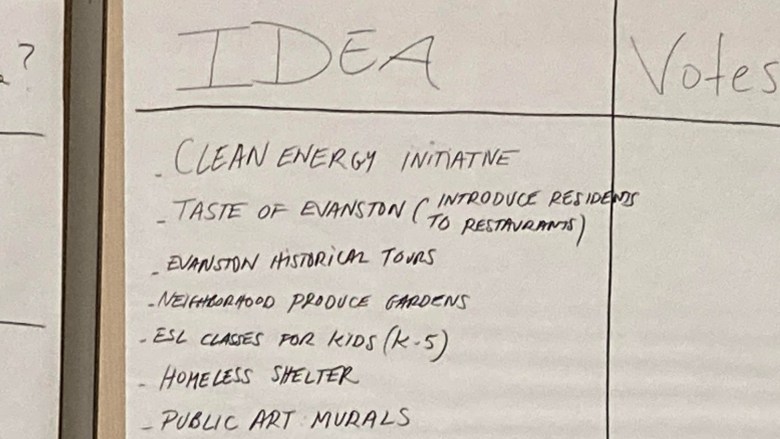“Don’t hold back” on any suggestions.
That was the advice from one of the facilitators at Tuesday night’s first meeting on how $3 million in federal funds should be spent in the city next year.
The money is being set aside out of Evanston’s 2023 budget, for a public vote on specific proposals, outside of the normal City Council approval process.
It’s called “participatory budgeting,” where citizen volunteers come up with a series of proposals, which are then winnowed down to about 12-14 finalists.
Those finalists, with costs attached, then go to a public vote. The number of winners will be determined before then by a volunteer panel.
“I got involved because I want to make Evanston a better place,” said volunteer coordinator and 4th Ward resident Jean Cunningham.
“We’re talking about spending money on what the community thinks are pressing needs.”
If all goes according to plan, the final projects will be voted on next fall, at a variety of locations around town.
About 50 residents and facilitators split into groups, coming up with suggestions ranging from increased funding for reparations, to additional infrastructure for bicycling, to more comfortable public benches.
2nd Ward resident Laurice Bell said she wanted to be a part of “activism in Evanston.”
Bell wanted to see some of the money used to help the Shorefront Legacy Center and its mission of educating about local Black history.
Among other suggestions from the brainstorming meeting were planting trees in neighborhoods where there is minimal tree canopy, fixing sidewalks,more community gardens, home weatherization in low income neighborhods, and well as water filters for those with water lines built using lead.
There were many other proposals as well.

Mia Xia, a Northwestern University student, was a facilitator, helping to lead a small group session Tuesday night.
Xia got involved because, as a social policy major, she’s “passionate about civic engagement.”
“Often,” she added, “government can seem detached” from the average person.
Participatory budgeting, she said, is a way to help people and policy reconnect.
While $3 million may sound like a lot of money, it’s less than one percent of the proposed 2023 Evanston city budget.

Participatory budget backers are hoping to energize citizens, although turnout in Rogers Park, the first such community in our area to have a participatory budget vote on spending, was less than overwhelming … only about 1% of those eligible.
In general, participatory budget averages 1-10% turnout around the nation, according to Matt Ouren, the city’s manager for the participatory project.
Ouren is hoping Evanstonians will turn out on the high end of that range.
Besides Evanston residents, those who go to school here, have children in school in town, own a business here, or work here are allowed to vote in the participatory budgeting election.
Those 14 and under are also eligible, with parental permission.
Because the dollars used are from a one-time federal grant, it’s unclear what the future may be for participatory budgeting once the federal funds aren’t available.
But for now, those involved are enthusiastic about getting the concept off the ground.
“It’s an experiment,” said volunteer coordinator Cunningham.
“I like experiments.”
To learn more about getting involved, and about other scheduled idea-generating sessions visit pbevanston.org.

This is the most anti-democratic initiative I could imagine. It allows our elected representatives a way out from doing their actual job and privileges the ideas from a very small number of people who likely are not representative of the population of people who have other things to do (like work and spend time with families).
Some of stuff they discussed like sidewalks and trees are things that should be done in the normal course of budgeting. They are also things they require technical competencies which are not held by the vast majority of the public. Why do we hire urban foresters or traffic engineers if their expertise isn’t part of the budgeting process?
Let’s say everyone votes for palm trees to be planted and the city forester says ‘those don’t grow here.’ Then the participation decision is either ignored or turns out to be a waste of taxpayer money. Luckily they aren’t dedicating a ton of money to this.
But it is emblematic of the tyranny of symbolism over substance that pervades local government. District 65 builds a school without assessing the impact on student learning. The library board reads out a ’land acknowledgment’ before their meetings. The city issues ‘reparations’ for a red lining policy they weren’t involved with.
It’s simply ridiculous.